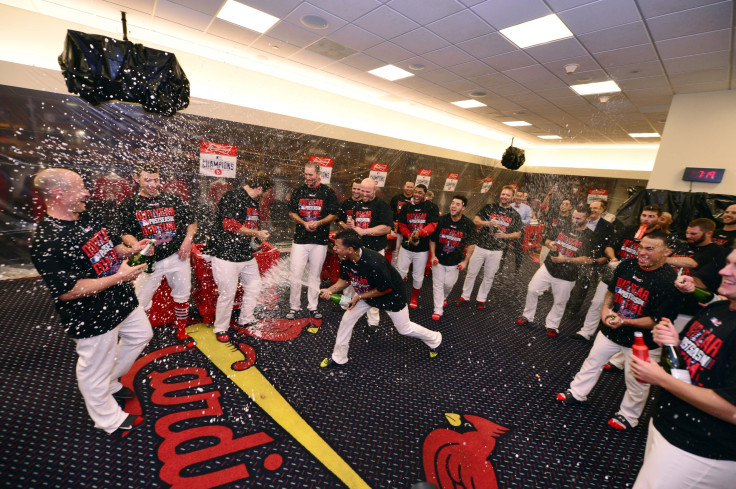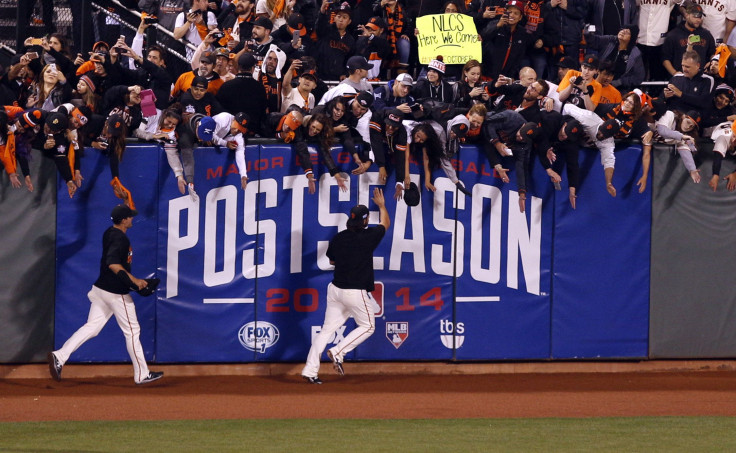Giants, Cardinals 2014 World Series Runs Prove Value Of Smart Trades, Signings

With neither an inflated payroll nor a first-ballot Hall-of-Fame bat, but rather through meticulous planning and smart financial decisions, the San Francisco Giants and St. Louis Cardinals have quietly pieced together a dominant presence in the National League.
Both teams will compete for a trip to the World Series after holding off two of the top clubs in the divisional series. The Cardinals defeated the Los Angeles Dodgers, a talent-rich team with a payroll of about $238 million, while the Giants got past the Washington Nationals, a club that led the NL in wins with a stellar pitching staff.
But success isn’t new to either club in recent seasons. The 2014 World Series will be the fifth straight time that one of the two clubs has reached the Fall Classic, with the Giants winning two World Series titles, and the Cardinals winning one. These accomplishments have occurred without Barry Bonds or Albert Pujols leading the way, and while the Dodgers and New York Yankees have thrown money at players and still failed to go deep into the postseason, the Cardinals and Giants have continued their excellent run with reasonable payrolls. Both clubs have not had a top-five payroll in the past five years, and seem to be doing just fine with their relatively inconspicuous personnel.
It seems that both clubs have figured out how to achieve consistent success without overpaying for superstars, and also not having to use the famous "Moneyball" strategy of the Oakland A's. The model might be even something for money managers seeking under-valued assets to look into.
Let's begin with St. Louis. Since 2000, the Cardinals have made the postseason 10 times, reaching the World Series four times and winning twice. They made the NL Championship Series eight times in that same span and achieved all that success without burdening their payroll with high-priced free agents and even turning their backs to homegrown stars.
After they captured the 2011 World Series in seven games against the Texas Rangers, St. Louis general manager John Mozeliak faced a serious dilemma. Pujols, a fan-favorite and superstar first baseman, was an unrestricted free agent and seeking a 10-year contract extension worth more than $200 million. Pujols was the heart of the Cardinals offense for the previous 11 years and captured three MVP awards.
But rather than succumb to the loyal Cardinals fans, Mozeliak opted not to offer a crippling contract that would’ve skewered his payroll for more than a decade. The gamble paid off, as Pujols, now 34, has since had three subpar years with the Los Angeles Angels with his career appearing to start its decline.
By passing on Pujols, no matter how difficult a business, and likely, personal decision it was, Mozeliak filled the massive void by re-signing Lance Berkman and adding Carlos Beltran. Later, in spite of his stellar play in two seasons, Beltran was sent packing in December, and has hit just .233 with 15 home runs for the New York Yankees.
Showing patience and recognizing an arm is better than an aging bat, eventually the Cardinals used their savings to hand starting ace Adam Wainwright a five-year, $97.5 million extension. The 33-year-old has won a minimum of 19 games in four of the last five seasons, and has a career 3.13 ERA in 19 postseason starts.
There is also something to be said for consistency and familiar faces in the front office. Over the last 20 years the Cardinals have had only two general managers, Mozeliak and his predecessor Walt Jocketty. Mozeliak was with the club since 1997 and served as an assistant scouting director, director of baseball operations and as assistant GM before moving up to vice president and full time GM in 2007. Having moved on to the Cincinnati Reds, it was Jocketty who brought in Hall of Fame manager Tony LaRussa and he plucked Pujols from the Dominican Republic in the 13th round of the 1999 draft.
Other owners throughout the Majors have taken notice to the lengthy rope that Cardinals owner William DeWitt, Jr. has given his GMs. Before Arizona, Colorado, San Diego and Atlanta let their GMs go this season, according to Grantland, the last time a GM lost his job was in 2011.
There’s also no questioning the importance of the smooth transition from LaRussa to current manager Mike Matheny. LaRussa retired as the third-winningest manager in history and with three World Series rings after 33 years on the bench. Matheny, who played catcher for LaRussa for five seasons, took over following LaRussa’s retirement in 2011 with no prior managing experience at the Major League level and as the youngest manager in the game. St. Louis has won an average of 91 games in the regular season and now reached the NLCS for the third straight season under Matheny.
Perhaps the big business takeaway from the Cardinals' success is to place a strong emphasis on assessing your talent, and be prepared to let them walk before their value declines.
Similar to Mozeliak’s choice to let Pujols walk, the Giants also reached an impasse with homegrown starter Tim Lincecum. Although in this case it backfired and San Francisco persevered.

General manager Brian Sabean can be credited for keeping the Giants competitive despite a highly questionable offseason decision. After posting disappointing numbers in the 2012 and 2013 seasons, former ace and Cy Young winner Lincecum was still rewarded with a $35 million, two-year contract through the 2015 season. It was a deal that had many baseball experts scratching their heads, and seemed more like a kind gesture for Lincecum’s years of great service as a star pitcher than a payment for future production. While Lincecum showed flashes of brilliance in 2014, the right hander failed to earn his salary with a 4.74 earned-run average, and hasn’t thrown one postseason pitch.
Otherwise, Sabean has made several smart moves to keep the Giants in the postseason hunt. In June, he acquired Jake Peavy from the Boston Red Sox, and took on about $2.5 million of his contract for two months of the regular season. The investment paid dividends, as Peavy rebounded from a poor season in Boston to become a reliable starter in San Francisco. Sabean also took a chance on injury-plagued outfielder Michael Morse in the offseason, signing him to a one-year deal worth $6 million, with the hope that he would regain his past form. Morse responded with his hightest hit total since 2011, his best season. Tim Hudson, who at age 39 was regarded as “past his prime,” was another Sabean free-agent signing that paid off. Trading for outfielder Hunter Pence also worked out, with the three players the Giants sent to the Philadelphia Phillies having yet to produce in the Majors.
Sabean has also been shrewd with deals that didn’t grab headlines. A trade that somewhat flew under the radar, but had positive results, was a deal that sent elite pitching prospect Tim Alderson to the Pittsburgh Pirates for Freddy Sanchez, who would bat No. 2 in the Giants lineup that won the 2010 World Series. Sanchez posted solid numbers, batting .292 with seven home runs that season, while Alderson’s chances of ever playing in the Majors seems very slim. Sabean chose to deal Alderson instead of another top pitching prospect, who was receiving nearly equal praise at the time of the deal: Madison Bumgarner, the club’s current ace.
Like the Cardinals, the Giants have maintained their brain trust. Sabean has teamed with manager Bruce Bochy to form one of the steadiest partnerships in baseball. Sabean has been with the club for 18 seasons, while Bochy joined the Giants in 2007. In baseball years, that can seem like an eternity. General managers and managers are often the scapegoat for poor seasons, but ownership kept their faith in the pair despite two rocky seasons that led up to the 2010 title. The Giants finished 16 games back of first place in the NL West, but responded with a 12-win increase the following season without making a major free-agent signing.
Yusmeiro Petit is an example of how the Sabean-Bochy pairing has kept the Giants an elite club. An inconsistent starter with the Arizona Diamondbacks, Petit was signed to a minor-league contract in 2012, and has bounced around as a starter and reliever, but to positive results. He posted a respectable ERA of 3.56 in 2013 and 3.69 in 2014, and was paid just $845,000 this season. At one point in 2014, Petit broke a record for most consecutive batters retired, and in 2013 he came within a strike of a perfect game.
The Petit Experiment is a unique one for a business manager. There are positives that can come out of giving a beleagured worker a new opportunity. Positive results can occur if they are tweaked for better utilization.
The Cardinals and Giants haven't broken ground with their acquisitions and strategy. Several teams have used similar offseason moves to strengthen their club. But when the likes of the Dodgers and Yankees liberally spend and come up short, it might be a wise to try emulating how the two 2014 NLCS teams have conducted business.
© Copyright IBTimes 2024. All rights reserved.





















